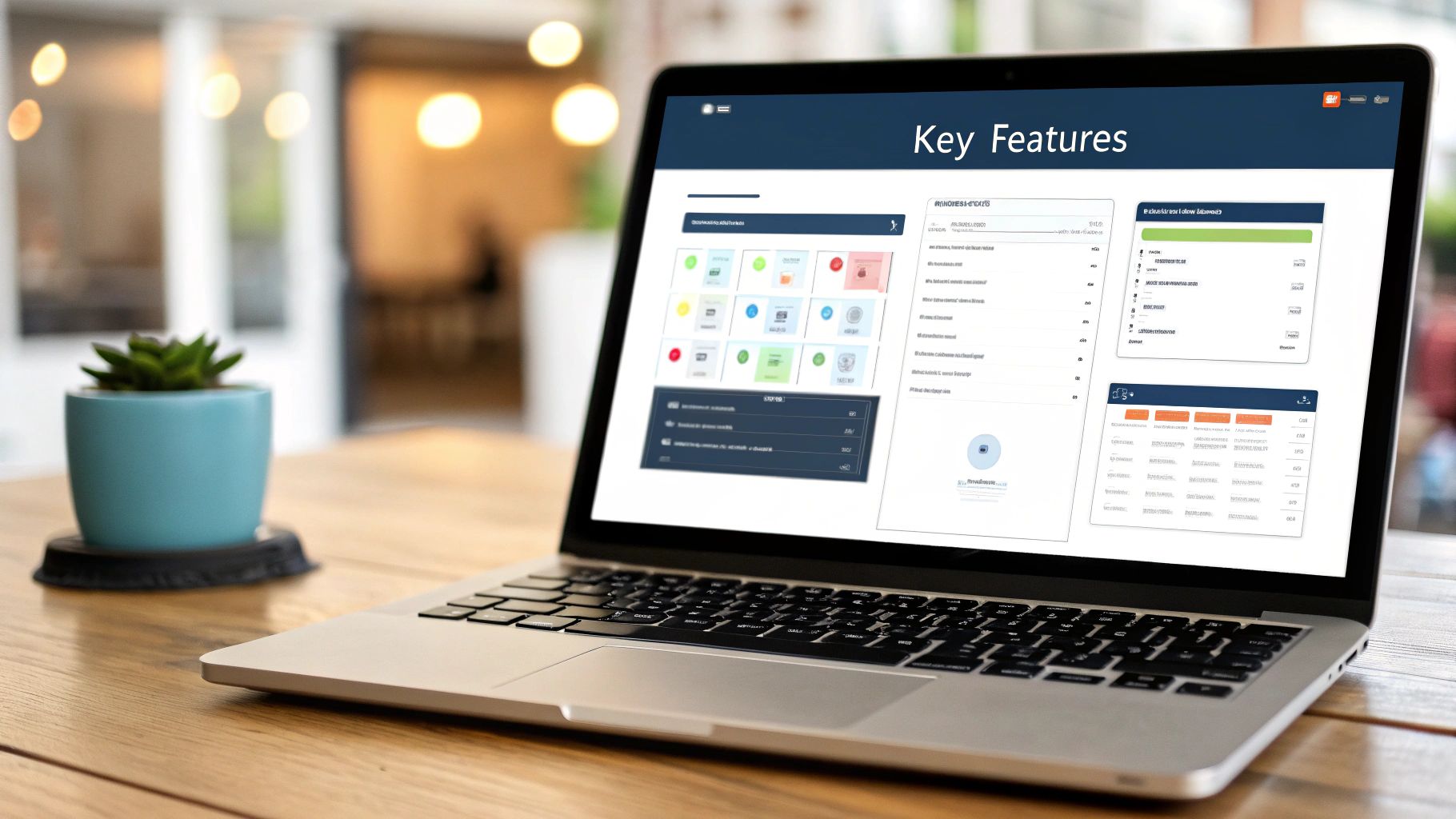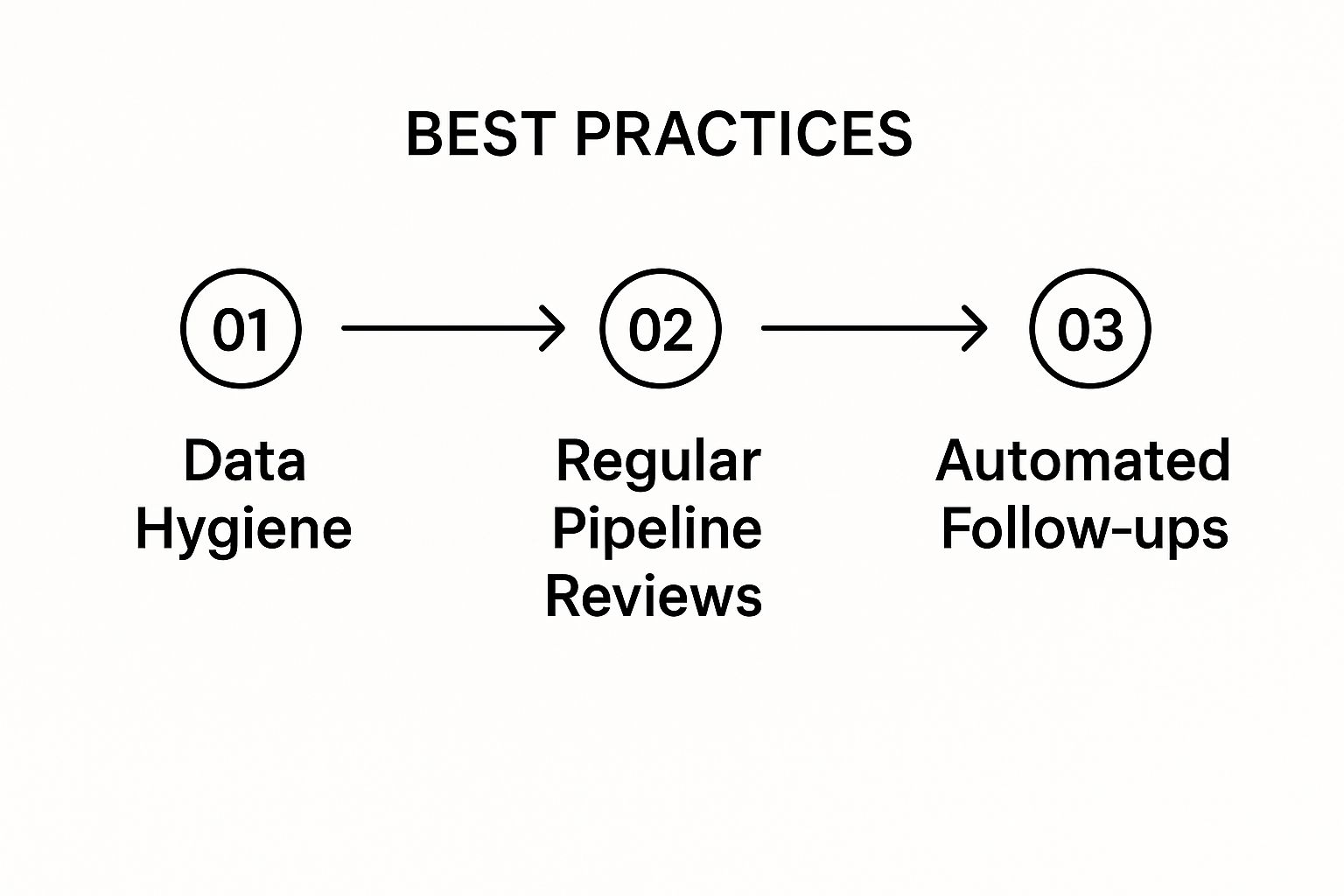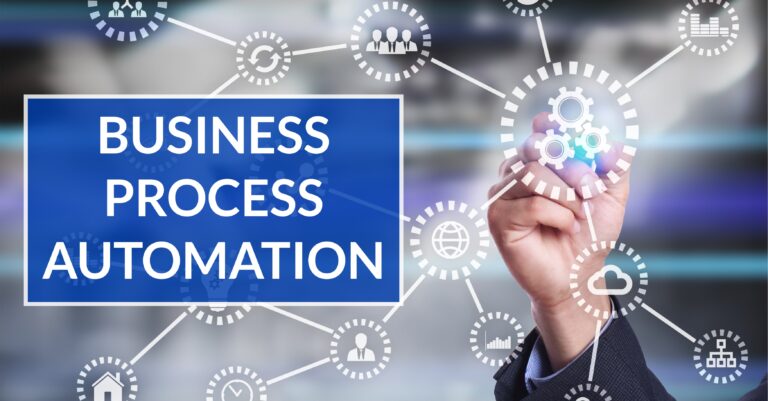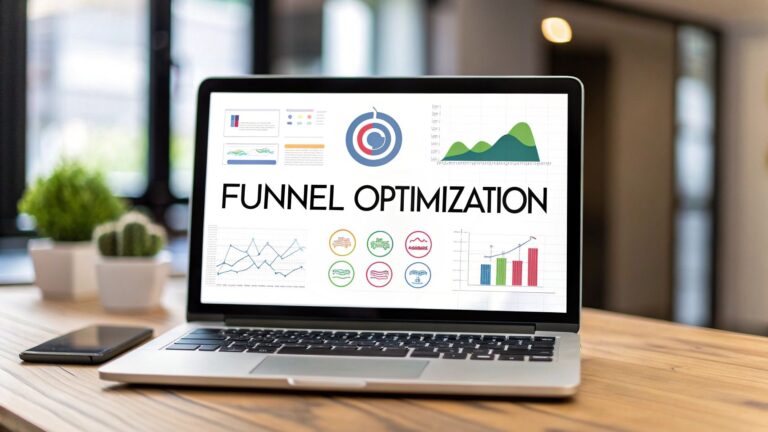Master Your Sales Pipeline Management Software
At its heart, sales pipeline management software gives you a visual, real-time snapshot of your entire sales process. Think of it as a specialized tool designed to help your team track potential customers as they move through specific stages, from that first "hello" all the way to a signed contract. It's all about making sure no opportunity slips through the cracks.
Your Sales Command Center
Picture your sales process as a factory assembly line. Raw materials (your new leads) come in one end, move through different workstations like qualification and proposal, and hopefully, emerge as finished products—closed deals. Now, imagine trying to run that factory without a control panel. Chaos, right? Parts would go missing, bottlenecks would jam up the works, and production would grind to a halt.
That’s what sales pipeline management software is: the master control center for your revenue factory. It provides a clear, visual map of every single deal in progress. Instead of digging through scattered spreadsheets, sticky notes, or relying on memory, your team gets a centralized dashboard that answers critical questions in an instant.
From Spreadsheet Chaos to Software Clarity
Not long ago, sales teams were stuck wrestling with clunky, messy spreadsheets to track their deals. This manual approach was not only slow but also a magnet for errors, making true team collaboration a pipe dream. Important details would get lost, follow-ups were easily forgotten, and forecasting felt more like reading tea leaves than a business science.
Modern pipeline software changes all of that.
At its core, sales pipeline management software transforms abstract sales efforts into a predictable, optimized, and transparent revenue engine. It moves your team from guessing where the money is to knowing exactly where it is and how to get it.
This shift isn't just a "nice-to-have"; it's a fundamental part of scaling a business. The demand for these tools is exploding for a reason. The global market for this software was valued at roughly USD 3.8 billion in 2023 and is expected to rocket to USD 10.2 billion by 2032. This reflects a massive trend toward digitizing and fine-tuning sales workflows.
To get a better sense of this shift, let's compare the old way with the new.
Spreadsheet Chaos vs Software Clarity
This table breaks down the key differences between managing your sales process manually in spreadsheets versus using dedicated software.
| Feature | Manual Tracking (Spreadsheets) | Pipeline Management Software |
|---|---|---|
| Visibility | Fragmented & static. Hard to see the big picture. | Centralized & dynamic. Real-time view of all deals. |
| Data Entry | Manual, tedious, and prone to human error. | Automated data capture and updates. |
| Collaboration | Difficult. Version control is a nightmare. | Seamless. The entire team works from one source of truth. |
| Forecasting | Guesswork based on outdated, unreliable data. | Accurate, data-driven revenue predictions. |
| Automation | None. Every task is done by hand. | Automates follow-ups, reminders, and data entry. |
| Deal Health | Almost impossible to track deal momentum or spot risks. | Instantly flags stalled deals and at-risk opportunities. |
The contrast is pretty stark. One method keeps you stuck in administrative quicksand, while the other gives you the clarity and control needed to drive growth.
How It Works in Practice
Sales pipeline management software is a fantastic example of Digital Process Automation (DPA) applied directly to sales. It's designed to streamline how you work and boost efficiency. Instead of just being a digital address book that stores contact info, this software is all about movement and action. It organizes your opportunities into visual stages, which might look something like this:
- Lead In: A brand new, unvetted prospect lands in your system.
- Contact Made: Your team has kicked off the first conversation.
- Qualified: You've vetted the prospect and confirmed they're a good fit.
- Proposal Sent: A formal offer is now in the prospect's hands.
- Negotiation: You're hammering out the final terms of the deal.
- Closed-Won/Lost: The deal is done—either as a win or a learning opportunity.
Each stage has clear criteria, so everyone on the team knows exactly what needs to happen to move a deal forward. This structured approach doesn't just bring order to the chaos; it also generates the clean data you need for truly accurate sales forecasting. It replaces guesswork with a clear, actionable path to revenue, making it an essential tool for any B2B or SaaS company serious about growth.
Core Features That Fuel Your Sales Engine

Let's be honest, good sales pipeline management software is a lot more than a fancy, digital address book. Think of it as the high-performance engine in your sales department, with every part working in sync to turn leads into revenue. To really get it, we need to look under the hood at the core features that make everything click.
These aren't just separate bells and whistles. They're interconnected systems that build on each other. A clear, visual pipeline makes your contact data useful. That data, in turn, powers automation. And all of it feeds into the analytics that give you real, actionable insights.
Your Team’s GPS: Visual Deal Stages
The feature everyone recognizes first is the visual pipeline. It’s usually a Kanban-style board, with columns for each step in your sales process. This isn’t just for show; it's a strategic GPS for your entire sales team.
Instead of digging through spreadsheets or chasing down reps for updates, anyone can see every deal in motion at a glance. A rep knows exactly which deals are moving and which ones are getting stuck. A manager gets an instant health check on the team's entire portfolio, spotting bottlenecks long before they threaten the forecast.
A Harvard Business Review study found a stunning 18% difference in revenue growth between companies that had a formal sales process and those that didn't. A visual pipeline makes that process real, tangible, and something the whole team can act on.
This visual clarity answers the all-important question—"What's next?"—for every single opportunity. It creates alignment and keeps everyone pointed in the same direction: closing the deal.
The Single Source of Truth: Centralized Contact Management
Behind every card on your visual pipeline is a goldmine of information. Centralized contact management acts as the single source of truth for every interaction you have with a prospect or customer. It's the master file that stops crossed wires and ensures everyone on your team has the full picture.
Imagine a prospect talks to an SDR in January, then gets back in touch with an account executive in March. Without this system, the AE is flying blind. With it, they can instantly see:
- Past Conversations: Notes from every call and meeting.
- Email History: A complete log of all email correspondence.
- Key Details: The prospect's pain points, budget, and who calls the shots.
- Activity Logs: A record of their website visits, content downloads, or support tickets.
This is what creates a seamless, professional experience for your buyer. Your team stops asking the same questions twice and starts having smarter, more relevant conversations that move deals forward faster.
The Repetitive Task Killer: Workflow Automation
One of the most powerful components of this engine is workflow automation. This is your secret weapon against the administrative grind that burns out even the best sales reps. It frees them from the tedious, low-value tasks so they can spend their time on what truly matters: building relationships and closing deals.
Automation in sales pipeline management software can be surprisingly versatile. For example, when a rep drags a deal from the "Qualified" stage to "Proposal Sent," the system can kick off a chain reaction:
- Create a Task: It can automatically pop a follow-up reminder on the rep's calendar for three days out.
- Send an Email: It can trigger a pre-written email sequence to the prospect with helpful case studies.
- Update a Field: It can instantly change the deal's status and notify the sales manager.
This doesn't just save time; it enforces your sales process so critical steps never get missed. The impact multiplies when you connect it with other tools. For example, using https://makeautomation.co/ai-lead-generation-software/ can fill the top of your pipeline automatically, and workflow automation then ensures every one of those new leads is nurtured perfectly.
The Engine Diagnostics: Reporting and Analytics
If the visual pipeline is your GPS, then reporting and analytics are the engine diagnostics. This is where the software transforms all your raw sales data into real intelligence, letting you make smart, data-driven decisions instead of just going with your gut.
You can finally get concrete answers to the tough questions. It's also worth noting that beyond these core features, you can Boost Efficiency with an AI Chatbot to handle those initial customer chats and qualify leads around the clock.
With solid analytics, you can track mission-critical metrics like:
- Conversion Rate by Stage: See exactly where in the process deals tend to fall apart.
- Sales Velocity: Measure the average time it takes for a deal to go from new lead to closed-won.
- Average Deal Size: Get a clear picture of your pipeline's actual value.
- Win/Loss Analysis: Dig into the common reasons you win or lose deals.
This kind of insight is absolutely essential for accurate forecasting. When you understand your historical performance, you can predict future revenue with confidence. That empowers leadership to make informed decisions about hiring, budgets, and the overall strategy of the business.
How This Software Transforms Your Bottom Line

Let's be honest: adding another tool to your company’s tech stack only matters if it helps you make more money. Bringing in sales pipeline management software isn't about shiny new features; it's about connecting your team's daily activities directly to real, measurable financial results. When you get it right, this software becomes a direct line to a healthier bottom line.
Think about the "before" picture for a moment—it's a scene many of us know well. A chaotic jumble of spreadsheets, sticky notes, and missed follow-ups. Sales forecasts that feel more like wishful thinking than solid projections. Now, picture the "after": a disciplined, high-performing team where every action is purposeful and easy to track. This isn't magic. It's the clarity that comes from having a structured process and total visibility.
The end game is simple: fewer leads slipping through the cracks, stronger customer relationships built on timely communication, and a clear, undeniable boost in revenue and ROI.
From Murky Forecasts to Data-Backed Confidence
One of the first and most powerful shifts you'll see is in your sales forecasting. It’s the jump from pure guesswork to data-driven certainty. With a clear view of your entire pipeline, you and your leadership team get a real-time, accurate picture of the revenue coming down the pike. Gut feelings are replaced by confident, strategic moves backed by hard numbers.
The real change is moving from reactive problem-solving to proactive strategy. You stop asking, "What just happened?" and start asking, "What's likely to happen next, and how can we shape that outcome?"
This newfound clarity helps you answer the big, expensive questions with precision. Do we have enough in the pipeline to hit next quarter's target? Is it time to hire more reps? Should we double down on that new marketing channel? The software gives you the data you need to make these high-stakes decisions correctly, directly fueling your profitability.
A Surge in Productivity and a Shorter Sales Cycle
When you standardize your sales process with software, you naturally unlock a huge productivity boost. Reps with a clear roadmap for every deal spend less time wondering what to do next and more time actually selling. Better yet, automation takes over the tedious administrative work—like sending routine follow-up emails or setting reminders—freeing up hours of valuable time each week.
This efficiency does more than just make your team happier; it directly shrinks your sales cycle. Research shows that companies using this kind of software see an average 15% increase in sales productivity and a 12% reduction in how long it takes to close a deal. By giving your team a structured playbook and a clear view of every stage, they can focus their energy where it counts and get deals over the finish line faster.
A shorter sales cycle means you see revenue in the bank sooner and your team has the capacity to chase more opportunities. It creates a powerful, self-sustaining loop for growth.
A Real-World Before-and-After Look
To really see the difference, let’s walk through a common scenario for a growing SaaS company.
Before Implementation:
- Lead Management: Leads from webinars, contact forms, and events are dumped into a shared spreadsheet. Reps are supposed to update it manually, but version control is a mess, and good leads constantly get lost in the shuffle.
- Forecasting: The sales manager spends hours every Monday morning chasing reps for individual updates just to piece together a shaky, unreliable forecast for the weekly leadership meeting.
- Performance: The star performers are successful, but they operate on instinct. New hires are thrown in the deep end and struggle to find a process that works, leading to high turnover and wildly inconsistent team results.
After Implementation:
- Lead Management: All leads are automatically captured, routed, and assigned within the software. Every call, email, and meeting is logged, creating a single source of truth and ensuring no opportunity is ever forgotten.
- Forecasting: The sales manager pulls an accurate, real-time forecast report in minutes. Meetings are no longer about status updates; they’re strategic discussions on how to move stalled deals forward.
- Performance: A standardized sales process acts as a clear playbook for success. New hires get up to speed in a fraction of the time, and the entire team’s performance becomes predictable and consistent.
This isn't just about getting organized; it's about building a scalable revenue engine. Automating these workflows is a perfect example of the broader advantages available, and you can explore the 10 business process automation benefits for 2024 to see how this applies across the board. The software provides the fundamental structure needed to turn chaotic activity into predictable growth.
Choosing The Right Software For Your Business
Picking the perfect sales pipeline management software can feel like an impossible task. There are so many options, and they all seem to promise the world. But you don't have to get lost in the noise.
With the right mindset, you can zero in on a solution that actually fits your business. The goal isn't just to check a box and buy a new tool; it's to find a system that will become a genuine partner in your growth.
The Three Pillars of Evaluation
Before you even look at a feature list, you need to focus on three core principles. Think of these as the absolute non-negotiables that separate a good-enough tool from a great one.
-
Scalability: The software that works beautifully for a scrappy team of five might completely buckle under the weight of a 50-person sales force. You have to ask the hard question: Will this tool grow with us? A truly scalable solution can handle a massive influx of leads, contacts, and daily user activity without a hiccup. Getting this right from the start saves you from a painful—and expensive—migration down the road.
-
Integration Power: Your sales pipeline software doesn't live on an island. It needs to play nicely with all the other tools your team relies on every single day. Does it connect effortlessly with your email client, marketing automation platform, or customer support desk? Solid integrations are the glue that holds your tech stack together, eliminating mind-numbing data entry and giving everyone a 360-degree view of the customer.
-
User Adoption: Honestly, this might be the most important pillar of all. You could have the most powerful software on the planet, but if your team finds it clunky and frustrating, it's completely useless. Is the interface clean? Is it intuitive? A complicated system will always be met with resistance, leading to bad data and even worse morale. Always prioritize a user-friendly experience that your team will actually want to use.
A tool is only as good as the people using it. Make sure you bring your sales reps into the conversation early. Their buy-in is absolutely critical for a successful rollout and seeing any real return on your investment.
These three pillars—scalability, integration, and adoption—are your foundation for making a smart choice. But your work isn't done yet. You also have to dig into the financials and support to make sure you're entering a healthy long-term partnership.
Understanding Value Beyond The Price Tag
It's all too easy to get fixated on the monthly subscription fee, but the real worth of sales pipeline management software is so much more than that. You have to look at the whole picture.
The shift to remote and hybrid work, especially after 2020, really pushed cloud-based solutions into the spotlight. These tools became essential for keeping teams connected and productive, letting reps manage their pipelines from anywhere. If you want to dive deeper, you can explore the key factors driving the market for sales pipeline management software.
When you're comparing your final options, weigh these practical factors:
- Pricing Models: Are you paying per user, by feature tier, or based on your contact list size? Make sure the model makes sense for your current team and your growth plans.
- Customer Support: When a problem pops up (and it will), how fast can you get real help? Look for providers with a reputation for responsive and knowledgeable support, whether that’s through live chat, phone, or email.
- Onboarding and Training: Does the company just hand you the keys and walk away, or do they offer resources to get your team up to speed? A smooth onboarding process is everything for driving adoption and getting value from day one.
It’s also smart to see how different CRMs stack up, since many have powerful pipeline features built right in. This is especially helpful for smaller businesses. For instance, there are great guides that compare the best CRMs for freelancers and solopreneurs. By carefully considering all these elements, you can confidently choose a tool that truly aligns with your budget, workflow, and biggest goals.
Your Step-by-Step Implementation Roadmap
Bringing new sales pipeline management software into your business is much more than just a technical install. It's a genuine shift in how your entire sales team thinks and operates. Getting it right from the start means blending your people, your processes, and the new technology into a cohesive system.
This roadmap will walk you through the essential steps, helping you avoid the common stumbles that can trip up even the best teams. The goal isn't just to install the software—it's to build a reliable revenue engine that your team actually wants to use.
Define Your Sales Stages
Before you even think about migrating data or setting up user accounts, you have to get crystal clear on your sales process. This is the foundation everything else is built on. Each stage in your pipeline needs to be distinct, with concrete, non-negotiable rules for moving a deal from one stage to the next.
Think of it like an assembly line. A car part can't move to the painting station until it passes the quality check at the assembly station. It's the same with your sales process.
For instance, a deal can’t be moved from "Qualified Lead" to "Proposal Sent" until the prospect has:
- Confirmed their budget aligns with your pricing.
- Connected you with the ultimate decision-maker.
- Agreed on a realistic timeline for their purchase.
This level of discipline is crucial. It stops your pipeline from getting bloated with deals that aren't actually going anywhere, giving you a real, honest look at your potential revenue instead of a list of wishful thinking.
Clean and Migrate Your Data
Your shiny new software is only as smart as the data you feed it. If you just dump messy, old information from spreadsheets or a previous CRM, you're just moving your old problems into a fancier, more expensive home. Treat this as a golden opportunity for a fresh start.
Before you migrate anything, commit to a serious data cleanup. This means rolling up your sleeves and:
- Removing Duplicates: Find and merge all those duplicate contacts and company records.
- Updating Information: Fix outdated email addresses, wrong phone numbers, and old job titles.
- Archiving Old Leads: Get rid of contacts that haven't shown any interest in ages.
A clean data migration isn't just an admin task; it's a strategic move. Starting with accurate data builds instant trust in the new system and paves the way for reporting and forecasting you can actually rely on.
Secure Team Training and Buy-In
This is the step everyone underestimates, and it's almost always the one that makes or breaks the entire project. If your sales reps don’t get why you’re making this change, or if they find the tool clunky, they simply won't use it. Low adoption is the fastest way to turn your investment into a write-off.
Good training is more than a quick tour of the features. It needs to show them exactly how the software makes their job easier and helps them hit their targets. Frame the benefits in their language: "This automation will save you 5 hours a week on manual follow-ups," or "This visibility will help you close deals 15% faster."
Run some formal training sessions, but also provide plenty of time for hands-on practice. Offer one-on-one coaching for anyone struggling. The real secret? Get your top performers on board early and have them act as champions, sharing their wins to build excitement and momentum.
This flow chart gives a great visual for keeping your pipeline healthy long after the initial setup.

As you can see, it all starts with great data, which fuels effective pipeline reviews, which are then supercharged by smart automation.
Activate Integrations and Automations
With the foundation in place, it’s time to let the software do the heavy lifting. Connect it to the other tools your business runs on, like your email marketing platform, calendar app, and customer support desk. This creates a single source of truth and a unified view of every customer interaction.
Next, start flipping the switches on some simple, high-impact automations. A perfect starting point is automatic task creation. For example, you can set a rule to automatically create a "Follow-up" task for a rep 3 days after they send a proposal. It’s a small tweak that enforces consistency and makes sure valuable opportunities don't slip through the cracks.
As your team gets comfortable, you can start building more sophisticated workflows. For a deeper dive into what's possible, check out this excellent roadmap to implementing business process automation to see how these ideas can be applied across your entire business.
Best Practices For Pipeline Management Mastery

Just having sales pipeline management software isn't the win; it's the starting pistol. The real edge comes from mastering the tool—turning it from a digital filing cabinet into an engine that actively drives revenue. Top-tier sales teams aren't just lucky; they're disciplined, and their success is built on habits that anyone can adopt.
Think of it this way: these practices move your team from being firefighters, constantly reacting to stalled deals and missed forecasts, to being architects who design and control their outcomes. This is the shift that separates the good from the great and makes your pipeline a predictable source of growth.
Conduct Weekly Pipeline Reviews
The best sales teams I've seen live and breathe the weekly pipeline review. It's a non-negotiable part of their rhythm. In fact, research shows that 72% of sales managers hold these meetings with their reps multiple times a month. But here’s the secret: they aren't status updates. They're strategic huddles.
Instead of asking the tired old question, "What's the update on this deal?" the conversation shifts to strategy. You should be discussing roadblocks, brainstorming creative next steps, and deciding which deals need more firepower. This simple change turns a reporting chore into a powerful coaching session that actually helps reps advance their deals.
A landmark study by Harvard Business Review found that companies mastering three key pipeline practices achieved 28% higher revenue growth. You guessed it—consistent, strategic reviews are one of those core three.
This weekly cadence builds a culture of accountability and keeps everyone pulling in the same direction. It ensures no deal ever gathers dust.
Maintain Impeccable Data Hygiene
Your software is only as smart as the information you feed it. A pipeline cluttered with outdated notes and dead-end deals isn't just useless; it's dangerous because it leads to bad decisions. Committing to data hygiene means your pipeline is always a reliable source of truth, giving you a crystal-clear view for forecasting and planning.
This discipline isn't complicated. It comes down to a few key actions:
- Update in Real-Time: Reps should get into the habit of updating deal stages and notes right after a call, not hoarding them for a Friday afternoon data dump.
- Drop Dead Leads: Be ruthless. If a deal has gone cold and the prospect is ghosting you, close it out. Letting go of a lead that won't buy frees up precious time to chase opportunities that will.
- Enforce the Rules: Use your software's features to your advantage. Make certain fields mandatory before a rep can move a deal to the next stage. This guarantees you capture the critical information you need, every single time.
Clean data is the foundation for everything else. It ensures your reports are accurate, your forecasts are trustworthy, and your team is focused on what truly matters.
Continuously Optimize Your Stages and Metrics
Your sales process should never be set in stone. The market shifts, your buyers' needs change, and your strategy has to evolve right along with them. The smartest organizations use their sales pipeline management software as a lab for continuous improvement.
They do this by relentlessly tracking a few key metrics to spot weaknesses and opportunities:
- Stage-by-Stage Conversion Rates: This metric shows you exactly where deals are getting stuck. A low conversion from "Proposal Sent" to "Negotiation," for example, might scream that your pricing is off or your value proposition isn't landing.
- Deal Velocity: How long does a deal sit in each stage? Measuring this helps you pinpoint bottlenecks and find ways to shorten your entire sales cycle. More speed means more wins.
- Average Deal Size: Keeping an eye on this ensures your team is hunting the right size of game—the high-value opportunities that will actually move the needle for the business.
By regularly diving into this data, you can make intelligent tweaks to your sales stages, your messaging, and your overall approach. This constant optimization is what turns a static pipeline into a well-oiled machine that gets better and more predictable over time.
Frequently Asked Questions
Even with a solid plan, you're bound to have some questions when you're thinking about new sales pipeline management software. Let's tackle some of the most common ones that come up, so you can feel confident about the path forward for your business.
CRM vs. Sales Pipeline Software
It's easy to get these two confused because they definitely overlap, but they're built for different primary jobs. Think of a CRM as your master address book for every customer interaction—it holds all the relationship history and data across the entire customer lifecycle.
Sales pipeline management software, on the other hand, is a specialist. It zeroes in on the active sales process, giving you a powerful, visual way to track and manage leads as they move through each stage on their way to becoming a customer. While many modern CRMs have great pipeline features built-in, dedicated tools often give your sales team a cleaner, more focused experience without all the extra noise.
How Often Should My Team Review Our Pipeline?
For most sales teams, the sweet spot is a weekly pipeline review. This cadence is frequent enough to catch deals that are starting to stall and make smart adjustments to your forecast, but it avoids the trap of micromanaging your reps. In fact, research from Vantage Point shows that 72% of sales managers are already holding these check-ins multiple times a month.
The real purpose of these meetings isn't just a round-robin of status updates. It should be a collaborative strategy session. Reps need to talk about what's blocking them so the team can brainstorm real solutions, keeping the pipeline healthy and accurate.
Can Small Businesses Benefit From This Software?
Absolutely. You could argue that small businesses have the most to gain because every single deal is so critical for survival and growth. Without a system, sales can feel chaotic, and it's far too easy for good leads to fall through the cracks.
This kind of software brings immediate organization and establishes a professional sales process from day one. With so many vendors now offering affordable plans designed for smaller teams, it's a smart investment that helps you compete with bigger players and build a scalable foundation for the future.
Ready to stop guessing and start building a predictable revenue engine? MakeAutomation specializes in implementing the automated systems and streamlined sales processes your business needs to scale. Discover how we can optimize your sales pipeline today!







